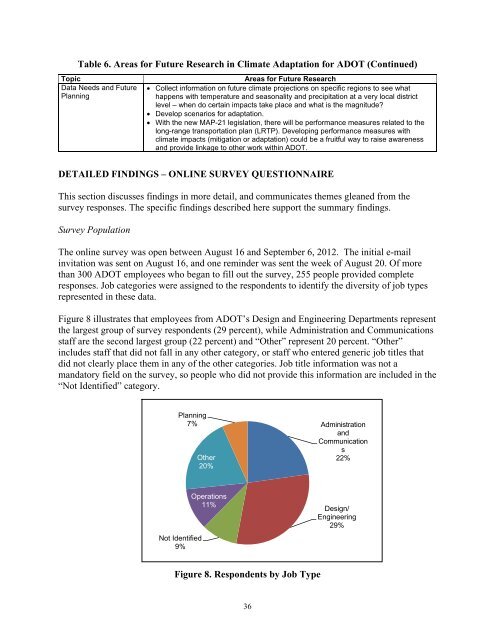SPR-696: Preliminary Study of Climate Adaptation for the Statewide ...
SPR-696: Preliminary Study of Climate Adaptation for the Statewide ...
SPR-696: Preliminary Study of Climate Adaptation for the Statewide ...
Create successful ePaper yourself
Turn your PDF publications into a flip-book with our unique Google optimized e-Paper software.
Table 6. Areas <strong>for</strong> Future Research in <strong>Climate</strong> <strong>Adaptation</strong> <strong>for</strong> ADOT (Continued)TopicData Needs and FuturePlanningAreas <strong>for</strong> Future Research Collect in<strong>for</strong>mation on future climate projections on specific regions to see whathappens with temperature and seasonality and precipitation at a very local districtlevel – when do certain impacts take place and what is <strong>the</strong> magnitude? Develop scenarios <strong>for</strong> adaptation. With <strong>the</strong> new MAP-21 legislation, <strong>the</strong>re will be per<strong>for</strong>mance measures related to <strong>the</strong>long-range transportation plan (LRTP). Developing per<strong>for</strong>mance measures withclimate impacts (mitigation or adaptation) could be a fruitful way to raise awarenessand provide linkage to o<strong>the</strong>r work within ADOT.DETAILED FINDINGS – ONLINE SURVEY QUESTIONNAIREThis section discusses findings in more detail, and communicates <strong>the</strong>mes gleaned from <strong>the</strong>survey responses. The specific findings described here support <strong>the</strong> summary findings.Survey PopulationThe online survey was open between August 16 and September 6, 2012. The initial e-mailinvitation was sent on August 16, and one reminder was sent <strong>the</strong> week <strong>of</strong> August 20. Of morethan 300 ADOT employees who began to fill out <strong>the</strong> survey, 255 people provided completeresponses. Job categories were assigned to <strong>the</strong> respondents to identify <strong>the</strong> diversity <strong>of</strong> job typesrepresented in <strong>the</strong>se data.Figure 8 illustrates that employees from ADOT’s Design and Engineering Departments represent<strong>the</strong> largest group <strong>of</strong> survey respondents (29 percent), while Administration and Communicationsstaff are <strong>the</strong> second largest group (22 percent) and “O<strong>the</strong>r” represent 20 percent. “O<strong>the</strong>r”includes staff that did not fall in any o<strong>the</strong>r category, or staff who entered generic job titles thatdid not clearly place <strong>the</strong>m in any <strong>of</strong> <strong>the</strong> o<strong>the</strong>r categories. Job title in<strong>for</strong>mation was not amandatory field on <strong>the</strong> survey, so people who did not provide this in<strong>for</strong>mation are included in <strong>the</strong>“Not Identified” category.Planning7%O<strong>the</strong>r20%AdministrationandCommunications22%Not Identified9%Operations11%Design/Engineering29%Figure 8. Respondents by Job Type36
















